In oil flooded screw compressor / oil injected screw compressor oil is injected to the compression chamber to cool and lubricate the compressor element and to reduce the return leakage to the intake.
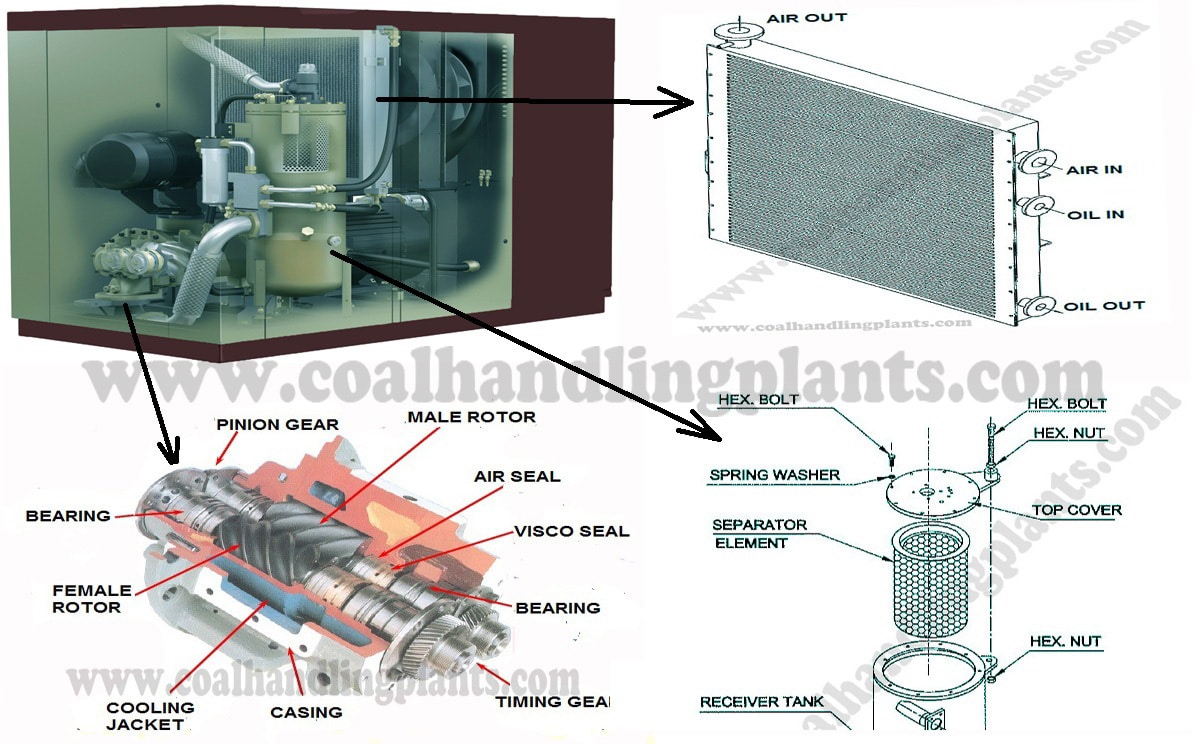
Main Components Used In Oil flooded Screw Compressor / Oil Injected Screw Compressor
1. Air Filter Element
Air filter element are used to filter the air from dust and dirt.
2. Intake Valve Assembly
Before the air enters into airend, it passed the intake valve assembly. This valve opens and closes the air supply to the airend.
3. Airend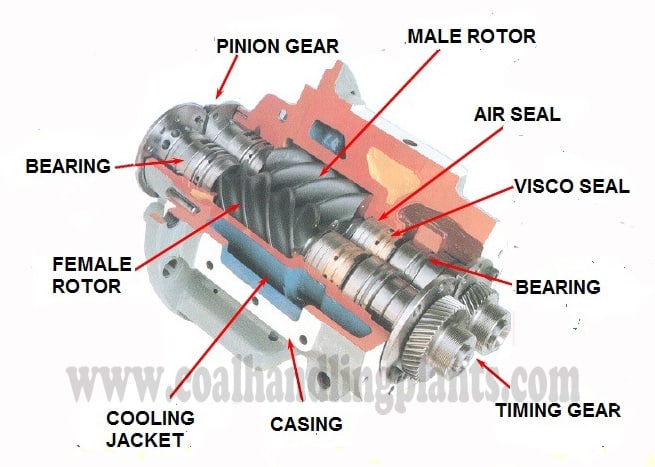
Airend is the main component of the compressor package in which atmospheric air is being compressed during the rotation of optimally designed twin helical screws. During compressing process oil is injected in the airend for lubricating and sealing off the clearances between the screws.The airend is coupled directly to the electric motor through a set of gears.
4. One Way Valve
The air-oil mixture leaves the airend through a one way valve. This valve sure that the mixture cannot flow back into the airend through the exit pipe.
5. Air / Oil Separator Tank
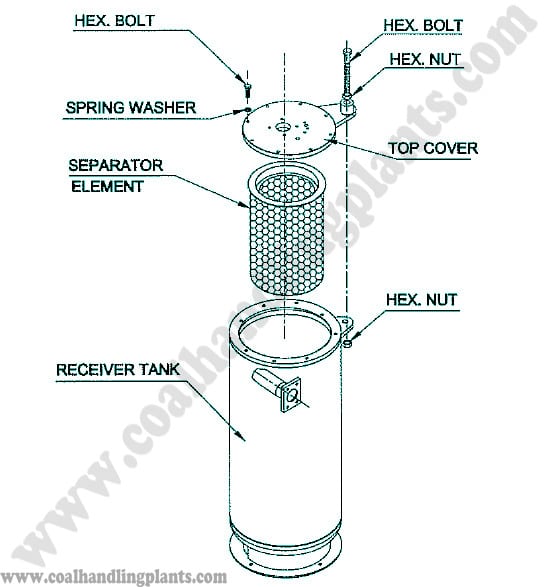
The function of air / oil separator tank is to separate the oil and air. Oil in the tank is first separated using a filter and remaining oil is removed using centrifugal force.
6. Minimum Pressure Valve
They are used to maintain minimum air pressure in air-oil separator tank so that positive oil flows is ensured. The valve is a spring loaded that opens at a certain pressure. The minimum pressure valve makes sure that there is always a minimum pressure inside the separator tank.
7. Safety Relief Valve
They are used to de-pressurize the compressor system if pressure exceeds beyond limits of the system.
8. Oil Level Indicator
This is mounted on air-oil separator tank. It gives visual indication of minimum and maximum level of oil present in compressor system.
9. Combi Cooler / After Cooler
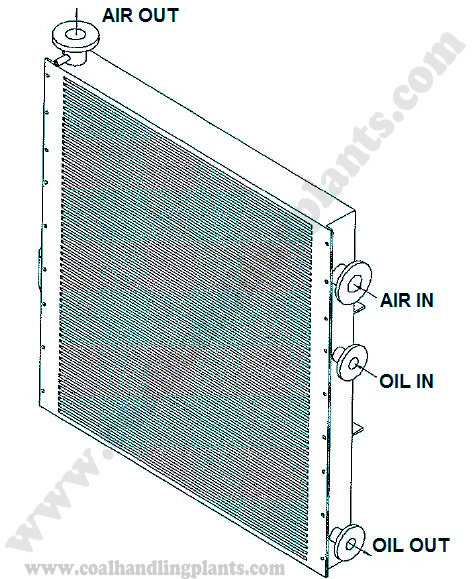
The separated oil and air is hot due to absorption of heat during compression. These hot air and oil is cooled by the combi cooler / after cooler.
10. Moisture Separator
Due to cooling down of air in after cooler, a lot of water vapor has condensed against the inside of the after cooler. This water is carried with the compressed air.
The function of moisture separator is to separates the water from compressed air.
11. Oil Filter
The function of oil filter is to remove all the dirt and dust that has collected in the oil. It is fitted between the after cooler and airend.
Working Of Oil Flooded Screw Compressor / Oil Injected Screw Compressor
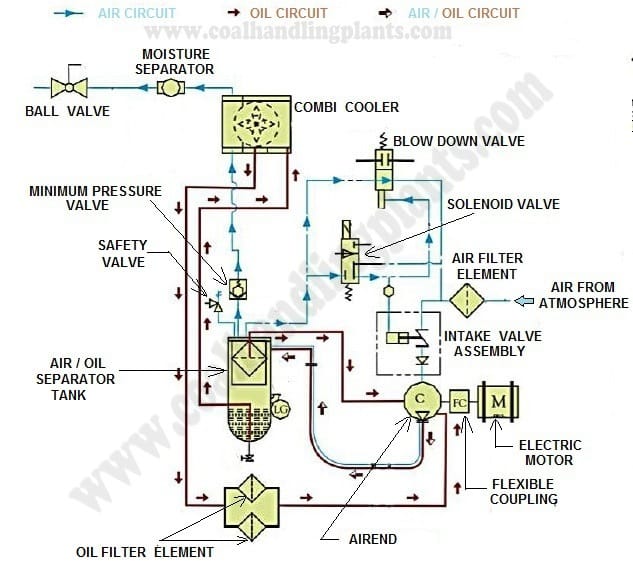
Air is sucked in by airend through the air filter and air intake valve. The air goes into the space between the interlocking screw. As the rotors turn, the air moves along and travels to other end of the compression chamber. During this compression process, oil is injected in the airend. The compressed mixture (air and oil) leaves the airend through a one way valve.
These mixture is then separated in air-oil separator. Some separated oil is collected at the bottom of the separator tank and is removed by the scavenge line and some oil is sucks back to the airend.
The clean compressed air which is separated from oil in air-oil separator tank is almost ready to leave the compressor but first passed the minimum pressure valve and the after cooler.
The separated hot oil is cooled by after cooler and again injected in the airend after passing through oil filter
Oil Flooded Screw Compressor / Oil Injected Screw Compressor Problems And Their Probable Causes
1. Problem – High Discharge Oil Temperature
- Probable Causes – Cooler chocked either externally or internally, low oil temperature, room / ambient temperature too high, oil filter chocked, poor quality of oil, blockage in oil injection orifice in, malfunctioning of temperature sensor or valve, erratic reading showing in PLC.
2. Problem – Oil Carryover
- Probable Causes – Oil level high, running at low pressure, separator failure, wrong oil grade used, scavenging line blocked, excess oil foaming.
3. Problem – Oil back flow through suction side
- Probable Causes – malfunctioning of Intake valve, solenoid valve, oil stop valve, discharge check valve, poor quality of oil.
4. Problem – Machine not building up full pressure
- Probable Causes – Air line leakage, dirty air filter, defective pressure regulator valve, malfunction of intake valve and solenoid valve.
5. Problem – Machine not starting
- Probable Causes – Main disconnect switch open, line fuse or control transformer fuse down, motor starter overload trip, low incoming voltage, wire loose connection, emergency push button locked / malfunctioning.
6. Problem – Machine shutdown with air demand
- Probable Causes – Low incoming voltage, loss of control voltage, separator element clogging/ defective, low pressure setting in transmitter.
7. Problem – Excessive operating pressure
- Probable Causes – Defective pressure transmitter and solenoid valve, defective intake valve.
8. Problem – Excessive oil in service line / consumption
- Probable Causes – Clogged return line strainer or orifice, separator element damage or not function properly, leak in lubrication system, excessive oil forming, oil level too high.
9. Problem – Oil leakage through suction side when the unit is switched off
- Probable Causes – Malfunctioning of oil stop valve, check valve, intake valve, solenoid valve.
RELATED SEARCHES: